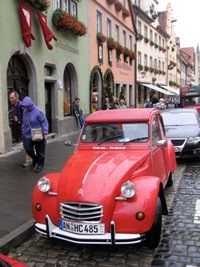An American Car Guy Across The Pond, Browsing Around Europe
By Steve Purdy
The Auto Channel
Detroit Bureau
My pretty blonde and I are just back from our first European trip where we visited sixteen cities in seventeen days – a whirlwind tour, indeed. Of course, we were awestruck by the ancient architecture, cultural discoveries and regional foods. But, as you might guess, this car guy found much of interest in the automotive realm.
We began our tour in Paris then visited Switzerland, Italy, Austria, Germany, The Netherlands, Belgium and England, in that order. Each city we explored had its own cultural character and its own automotive personality as well. Here are just a few observations:
It is certainly no surprise that the vast majority of cars and delivery vehicles are the basic European brands: the French Peugeot, Citroen and Renault; the German Mercedes, Audi and Volkswagen; and the Italian Fiat and Alfa Romeo. Outside of England we saw few Vauxhalls, MGs, Jaguars and Land Rovers.
Japanese cars are in evidence but obviously not a major player, with the possible exception of Toyota and Nissan. My favorite is the tiny Toyota IQ. It’s about the size and shape of a Smart but has a hint of a back seat. It also has a great deal of style and panache.
I was surprised when I would see our Chrysler products in the same form we have here in the U.S. since GM and Ford products are mostly different from ours. That first happened in Paris when an older Chrysler Sebring passed our tour bus. I then noticed that Chrysler Town and Country minivans were quite common within the taxi fleet. Rarely we might see a Chrysler 300 sedan and quite often a Chrysler PT Cruiser.
My pretty blonde and I were sitting at a little sidewalk café on a side street near our hotel in Rome having a pizza and a beer when the arched gate of an old apartment building opened immediately across the narrow street. I looked up to see a new Jeep Wrangler Limited pull out and jounce its way down the rough street to dice with all the fast little cars of that city. Somehow that seemed a bit incongruous.
From Paris through Italy to Austria the cars are amazingly small. Think of the smallest car we have in the US, perhaps the Smart by Mercedes. Many European manufacturers have cars that size as well, like the Toyota IQ mentioned above. But the smallest was one I spotted in Amsterdam that appeared to be only one-person wide. I think it was electric and it was so small it was allowed on the bike paths. I never got its name.
The next smallest cars are another genre we don’t have here. These are exemplified by the Ford Ka and Fiat 500 - little, usually stylish, jellybean-shaped cars with small engines and just about all manufacturers have them including Mercedes with the A-Class. Of course, they don’t need much power because they are so small and traffic so congested. By the way, we here in the US are about to get many of these cars.
Another thing we notice right away as we watch cars go by while we’re walking down the street is that cars here mostly have manual transmissions. That may be because they can squeeze a few more kilometers from a liter of fuel, or because the car is more responsive making it more fun to drive. Europeans are more likely than we to take great pleasure in driving.
And we US auto writers often talk about the fact that in Europe more than half the cars on the road are diesel powered, from the small ones to the big ones. Diesel fuel is less expensive than gasoline and mileage is better. The auto industry, there and here, has long since solved the problems of noise, performance and smoke from diesels.
The size of cars begins to change as we go further north. We noticed it just as we entered Germany from the south. By the time we were cruising around Munich we were seeing much larger cars. Of course, Munich is the home of BMW so we see many Bimmers there and the taxi fleet is just about all E-Class (mid-sized) Mercedes.
Most fun were the few old cars we encountered, perhaps because we saw them so seldom. In Paris and through much of our Italian experience we encountered two of our favorite oldies, the original Fiat 500 and the iconic Citroen 2CV. For those who don’t know the latter – it was to much of the world what the VW Beetle was to the US, a small, simple, no-frills car that could be repaired with chewing gum and coat hangers. (A photo of one leads this story.) The 2CV, or “Ugly Duckling” as it was affectionately known, was in full production virtually unchanged for around 50 years. The one in the photo above sport a slogan across its cowl that says, “It’s not a car. It’s a way of life.”
Though the weather was good on our end-of-summer trip we saw few oldies out there. A few others we did see include a lovely Austin Healey 300, an old Bentley and, crossing the Westminster Bridge, a cute Bug-Eye Sprite.
The most surprising car I spotted was on the German Autobahn near Munich in light traffic. A brash Chevy SSR, that oddball, hot rod pickup with retractable hardtop, passed us going about 120-mph.
© Steve Purdy, Shunpiker Productions, All Rights Reserved



